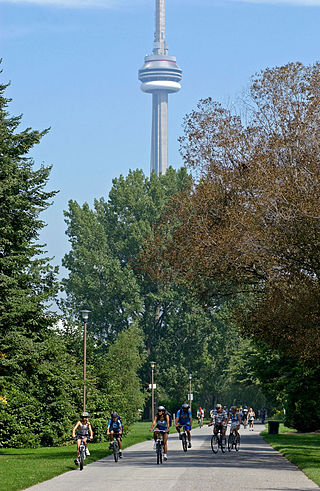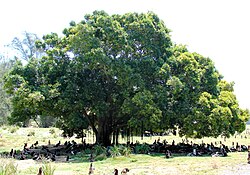
Quercus palustris, also called pin oak, swamp oak, or Spanish oak, is a tree in the red oak section of the genus Quercus. Pin oak is one of the most commonly used landscaping oaks in its native range due to its ease of transplant, relatively fast growth, and pollution tolerance.

Coppicing is the traditional method in woodland management of cutting down a tree to a stump, which in many species encourages new shoots to grow from the stump or roots, thus ultimately regrowing the tree. In a coppiced wood, which is called a copse or coppice, young tree stems are repeatedly cut down to near ground level, the resulting living stump called a stool. New growth emerges, and after a number of years, the coppiced tree is harvested, and the cycle begins anew. Pollarding is a similar process carried out at a higher level on the tree in order to prevent grazing animals from eating new shoots. Daisugi, is a similar Japanese technique.

Acer pseudoplatanus, known as the sycamore in the British Isles and as the sycamore maple in the United States, is a species of flowering plant in the soapberry and lychee family Sapindaceae. It is a large deciduous, broad-leaved tree, tolerant of wind and coastal exposure. It is native to Central Europe and Western Asia, from France eastward to Ukraine, northern Turkey and the Caucasus and southward in the mountains of Italy and northern Iberia.

Inosculation is a natural phenomenon in which trunks, branches or roots of two trees grow together in a manner biologically similar to the artificial process of grafting. The term is derived from the Latin roots in + ōsculārī, "to kiss into/inward/against" or etymologically and more illustratively "to make a small mouth inward/into/against"; trees having undergone the process are referred to in forestry as gemels, from the Latin word meaning "a pair".

The Chavez Ravine Arboretum, in Elysian Park, just north of Dodger Stadium, at 1025 Elysian Park Dr, Los Angeles, California, contains more than 100 varieties of trees from around the world, including what are believed to be the oldest and largest Cape Chestnut, Kauri, and Tipu trees in the United States. Admission to the arboretum is free.

The Hilltop Arboretum at Louisiana State University is an arboretum owned by the Louisiana State University. It is located at 11855 Highland Road, Baton Rouge, Louisiana, and open to the public free of charge during daylight hours seven days a week.

The University of Guelph Arboretum is an arboretum organized by the University of Guelph in Guelph, Ontario. It was formally established in 1970 by the university and aims to conserve biodiversity and connect people with nature through teaching, research, and community outreach. The space is 165 hectares and is open throughout the year.

The Appalachian mixed mesophytic forests is an ecoregion of the temperate broadleaf and mixed forests biome, as defined by the World Wildlife Fund. It consists of mesophytic plants west of the Appalachian Mountains in the Southeastern United States.

Flora of Azerbaijan or Vegetation of Azerbaijan refers to the plants, trees and flowers which can be found in Azerbaijan.

The woodlands of the Iberian Peninsula are distinct ecosystems on the Iberian Peninsula. Although the various regions are each characterized by distinct vegetation, the borders between these regions are not clearly defined, and there are some similarities across the peninsula.

Native trees in Toronto are trees that are naturally growing in Toronto and were not later introduced by humans. The area that presently comprise Toronto is a part of the Carolinian forest, although agricultural and urban developments destroyed significant portions of that life zone. In addition, many of Toronto's native trees have been displaced by non-native plants and trees introduced by settlers from Europe and Asia from the 18th century to the present. Most of the native trees are found in the Toronto ravine system, parks, and along the Toronto waterway system.

Weeping trees are trees characterized by soft, limp twigs. This characterization may lead to a bent crown and pendulous branches that can cascade to the ground. While weepyness occurs in nature, most weeping trees are cultivars. Because of their shape, weeping trees are popular in landscaping; generally they need a lot of space and are solitary so that their effect is more pronounced. There are over a hundred different types of weeping trees. Some trees, such as the cherry, have a variety of weeping cultivars. There are currently around 550 weeping cultivars in 75 different genera, although many have now disappeared from cultivation.
The Living Heritage Tree Museum is located in the city of Storm Lake, Iowa, US. It is an open-air museum dedicated to heritage trees, situated in Sunset Park on West Lake Shore Drive. It was founded by Stan Lemaster and Theodore Klein. The museum collection includes descendants of trees with historical connections to Joan of Arc, Johnny Appleseed, and Henry Wadsworth Longfellow.

The total forest area of Azerbaijan is 1,021,880 ha or 11.8% of the country's area. The forest biomes consist of temperate deciduous forests, temperate broadleaf and mixed forests, temperate coniferous forests and riparian forests. Specialists estimate that in the 8th-9th centuries the forest cover was around 30-35%, most of it situated in mountainous areas.

Species which are not native to a forest ecosystem can act as an agent of disturbance, changing forest dynamics as they invade and spread. Invasive insects and pathogens (diseases) are introduced to the United States through international trade, and spread through means of natural and human-dispersal. Invasive insects and pathogens are a serious threat to many forests in the United States and have decimated populations of several tree species, including American chestnut, American elm, eastern hemlock, whitebark pine, and the native ash species. The loss of these tree species is typically rapid with both short and long-term impacts to the forest ecosystem.



















